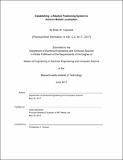Establishing a relative positioning system to achieve mobile localization
Author(s)
Copeland, Brian W
DownloadFull printable version (3.698Mb)
Other Contributors
Massachusetts Institute of Technology. Department of Electrical Engineering and Computer Science.
Advisor
Chris Schmandt.
Terms of use
Metadata
Show full item recordAbstract
There are an increasing number of situations in which the location of some digital device is known, but the methods to communicate with it are unknown. These situations can frustrate users and lead to the non-adoption to new, beneficial technologies. To combat this, I propose a relative positioning system between digital devices in order for each device to learn the relative locations of nearby devices. I explore three separate methods of establishing this positioning system. The first uses ultrasonic range-finding to localize nearby devices. The second uses WiFi range finding between mobile devices and stationary WiFi access points. The final method uses machine vision to jointly localize two devices observing the same scene from different angle. Ultimately none of these methods were fully implemented, but an analysis is given for the advantages and disadvantages of using these methods.
Description
Thesis: M. Eng., Massachusetts Institute of Technology, Department of Electrical Engineering and Computer Science, 2017. This electronic version was submitted by the student author. The certified thesis is available in the Institute Archives and Special Collections. "June 2017." Cataloged from student-submitted PDF version of thesis. Includes bibliographical references (pages 67-69).
Date issued
2017Department
Massachusetts Institute of Technology. Department of Electrical Engineering and Computer SciencePublisher
Massachusetts Institute of Technology
Keywords
Electrical Engineering and Computer Science.